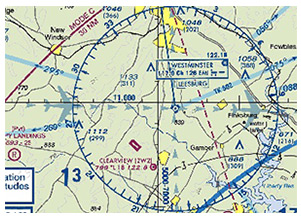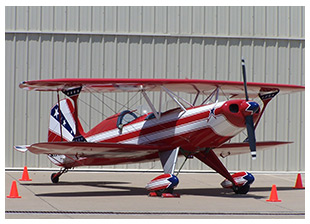Training Tips
|

Aircraft speed limits
Descending from a high cruise altitude at the end of a dual cross-country flight, a student pilot has acquired new insights into the normally aspirated trainer's flight characteristics at the upper limit of its altitude range. Compared to cruise at more typical altitudes, horsepower is less for a given rpm setting; climb performance eroded significantly as the aircraft neared its service ceiling.
It took a long time to climb to that lofty cruise altitude after takeoff, but higher-altitude cruise has its advantages. Overflying Class B and Class C airspace areas in a properly equipped aircraft is one. Another, for example in the mid-Atlantic states, can be the rare pleasure of surmounting the haze layer that so often restricts visibility, especially when a stable air mass is in place.
Having absorbed so many new flight impressions, the student is momentarily put off when the instructor taps the altimeter as the aircraft descends through 10,000 feet msl and quips, "Be sure to slow down to 250 knots."
How many times has that jest been sprung in the cockpit of a 110-knot trainer? Still, the CFI's "reminder" places useful focus on an aircraft speed regulation that states that "unless otherwise authorized by the Administrator, no person may operate an aircraft below 10,000 feet MSL at an indicated airspeed of more than 250 knots (288 m.p.h.)."
Not an issue for this flight! But a refresher on the rule's provisions will improve any pilot's situational awareness by serving as a reminder of how flight operations are conducted by the larger, faster aircraft sharing busy terminal airspace. The regulation also contains provisions restricting aircraft speed to a maximum of 200 knots "at or below 2,500 feet above the surface within 4 nautical miles of the primary airport of a Class C or Class D airspace area" and "in the airspace underlying a Class B airspace area designated for an airport or in a VFR corridor designated through such a Class B airspace area."
Note for example that a trainer departing Frederick Municipal Airport in Maryland west toward Martinsburg, West Virginia, or northeast toward the Westminster, Maryland, VOR would fly in the vicinity of high-traffic arrival and departure routes employing a range of altitudes, depicted on the Baltimore-Washington Terminal Area Chart.
Perhaps you will upgrade to a high-performance aircraft someday. Meanwhile, reviewing this regulation will make you a more effective plane spotter when ATC calls out fast traffic in busy (and haze-laden) airspace.
|
|
|
Flight Training News
|
|
Article
Jamie Crandall is flying again after a 17-year hiatus thanks to an AOPA Rusty Pilot seminar. And, he's helping pay for two other men to learn to fly. Read more...
 
Webinar
What can we learn from accident statistics?
There’s nothing more sobering than reading a general aviation accident report, because it reveals in plain language the types of mistakes that pilots make. Join Flight Training Editor Ian J. Twombly and Technical Editor Jill W. Tallman for a live Facebook chat on Tuesday, Oct. 7, at 3 p.m. Eastern. Their guest will be David J. Kenny, manager of aviation safety analysis for the Air Safety Institute. Kenny has spent years studying accident data for such publications as the institute's Joseph T. Nall Report. Join the conversation—one chatter will receive a $50 Aircraft Spruce gift card. Sign up here for an email reminder. Flight Training Facebook chats are sponsored by Aircraft Spruce & Specialty.
Florida Tech launches online BA in aviation management
Melbourne-based Florida Institute of Technology will launch a new online program on Oct. 27 in which students can earn a Bachelor of Arts degree in aviation management. The program addresses aviation safety, law, planning, and operations and includes a hands-on course that tasks students with creating an airline business plan and running a simulated aviation business.
Video
Flying VFR into instrument meteorological conditions makes as much sense as flying blindfolded. You'll get the idea when watching this Air Safety Institute "Flying Blind" Pilot Safety Announcement. Watch the video...
 
Apps of the week
Aviation developers unveil updates for nine flight planning apps.
Read more...
 
University aviation program receives flight simulator
The University of Maine at Augusta has bought a Redbird FMX flight simulator for its four-year aviation school, operated in conjunction with partner Maine Instrument Flight, reports CentralMaine.com. The program currently has 40 students.
|
|
|
Training Resources
|
|
Video
An hour before sunrise, the crew of an Atlanta-bound regional jet received a clearance to taxi to Runway 22 at Blue Grass Airport in Lexington, Kentucky. But in the darkness they mistook their position on the airport and lined up for the wrong runway. Watch the Air Safety Institute's accident animation to see what happened. Watch to learn more...
 
|
|
Did you know that student pilots who join AOPA are three times more likely to complete their flight training? Membership includes unlimited access to aviation information by phone (800/USA-AOPA, weekdays from 8:30 a.m. to 8 p.m. Eastern time) or from Flight Training Online or AOPA Online. If you're not already a member, join today and get the pilot's edge.
|
|
|
AOPA Live
|
|
AOPA Live This Week
An inspector general report adds to the criticism and confusion surrounding the 2020 Automatic Dependent Surveillance-Broadcast (ADS-B) mandate, and AOPA is calling for a fresh look at solutions. Also this week, Barrington Irving launches a round-the-world mission to get kids excited about science, and a 49-state journey to raise general aviation awareness takes off. AOPA Live This Week®, Sept. 25...
 
|
|
Career Pilot
|
|
Article
Sporty's has been added to the short list of training providers offering a newly required course for the multiengine airplane airline transport pilot (ATP) certificate, the company announced Sept. 24. Read more...
 
American gets OK for electronic flight attendant manuals
American Airlines, which said it was the first airline with a paperless cockpit, now has become the first mainline carrier to receive FAA approval to provide flight attendants with electronic manuals, accessible through a handheld tablet. By no longer printing and shipping updates, the carrier said it will save $300,000 annually—in addition to nearly $650,000 in annual fuel costs from replacing 5-pound paper manuals with lightweight, 5.3-inch Samsung tablets.
Southwest announces new service to Costa Rica
Southwest Airlines announced Sept. 12 that it has filed an application with the U.S. Department of Transportation to add its first Central American destination, with daily roundtrip service between Baltimore/Washington International Airport and San Jose, Costa Rica, beginning March 7, 2015. Costa Rica will be the sixth foreign country served by Southwest Airlines and the first new destination in the carrier's network after completing the integration of subsidiary AirTran Airways.
|
|
For more aviation career news, see the Flight Training website.
|
|
|
Plane Spotter
|

'Too' much fun
A pilot is regaling the local plane spotters about his aircraft—not only about how much fun it is to fly, but also on the pleasures of putting it together piece by piece. It's an open-cockpit, tailwheel-equipped, two-seat biplane that you can take on a cross-country or use for aerobatics (as it is rated to handle plus or minus 6 Gs). Indeed, the kit's manufacturer describes the Starduster Too SA300 as "without question the prettiest biplane ever built," and backers of the boast fly about 1,000 of the sporty aircraft.
|
Training Products
|
Jeppesen offers private pilot e-book
Jeppesen's new Guided Flight Discovery Private Pilot e-book covers topics including fundamental concepts, the mind/body/flight connection, FAA study questions, and summary checklists to mark progress. The cost is $79.99.
Helipad offers new kneeboard
The new Helipad iPad/iPad Mini kneeboard, created for helicopter pilots but suitable for fixed-wing cockpits, allows pilots to carry checklists and approach plates, and stores the iPad. Prices vary; see the website for more details.
|
|
Note: Products listed have not been evaluated by ePilot editors unless otherwise noted. AOPA assumes no responsibility for products or services listed or for claims or actions by manufacturers or vendors.
|
Member Benefits
|
|
Members only
Diabetes is an increasingly common condition. Diabetes mellitus treated with oral medications or insulin is one of the FAA's 15 specifically disqualifying medical conditions. Dr. Warren Silberman explains how to go through the AME-assisted special issuance process to obtain a medical certificate. Read more...
 
Member benefits
Allen Yarborough used AOPA Insurance Services for his aircraft coverage and was surprised at how inexpensive it was. Read more...
 
|
|
|
Blogs
|
|
Snow in September? Yes, when you're putting out the November issue of Flight Training magazine. Also: helicopters! Read more...
 
Blog
If you are flying in instrument conditions and your panel lights up with a caution light, or a series of cascading failures, are you ready to handle it? Opinion Leaders blogger Amy Laboda shares tips for using a simulator and mind exercises to increase your ability to handle problems quickly in the air before they escalate. Read more...
 
|
|
|
Instrument Tip
|
|
IFR Fix
What a pilot gleans from a PAPI's white and red lights depends on other design features of the approach, reviewed and noted during preflight planning. Read more...
 
|
Final Exam
|
Question
When is a pilot required to use an aircraft's position lights?
Answer
Position lights must be used during the period from sunset to sunrise, although there are special conditions for pilots in Alaska. While operating there, pilots must use position lights when a prominent unlighted object three statute miles away cannot be seen, or when the sun is more than six degrees below the horizon. (Source: 14 CFR 91.209).
|
|
Got a question for our technical services staff? Contact AOPA.
|
Career Opportunities
|
|
Aviation job board
TransPac Aviation Academy in Phoenix, Arizona, is currently hiring full-time certificated flight instructors. Responsibilities include conducting flight, ground, and simulator training under 14 CFR Parts 141 and 61. Successful candidates may be eligible to choose from an array of signing bonuses. Learn more now.
AOPA career opportunities
Ever dream of turning your passion for aviation into a career? We're looking for an executive assistant for accounting/finance and legal, legal services plan program manager, financial analyst, major gift officer, and account manager II. To learn more about other AOPA career opportunities, visit AOPA Online.
|
 |
Education and Seminars
|
Flight Instructor Refresher Courses
Sept 27-28 - Richmond, Virginia
Oct 11-12 - Santa Clara, California; Corpus Christi, Texas; Indianapolis, Indiana; and Nashville, Tennessee
Oct 18-19 - Columbia, South Carolina
Oct 25-26 - Windsor Locks, Connecticut; Fort Lauderdale, Florida; and Wichita, Kansas
For a complete schedule, see AOPA Online. Can't make it in person? Sign up for the Air Safety Institute's new Online eFIRC.
|
Air Safety Institute Safety Seminars
Sept 29 - Mesa, Arizona; Reno, Nevada; and Hampton, Virginia
Sept 30 - Sacramento, California; Tucson, Arizona; Richmond, Virginia; and Northglenn, Colorado
Oct 1 - Danville, Virginia; Colorado Springs, Colorado; San Jose, California; and El Paso, Texas
Oct 2 - Santa Rosa, California; Albuquerque, New Mexico; and Blacksburg, Virginia
Topics vary—for details and a complete schedule, see AOPA Online.
|
Rusty Pilot Seminars
Sept 27 - Burlington, Washington
Oct 2 - Independence, Oregon
Oct 3 - Frederick, Maryland
Oct 4 - Willoughby, Ohio; and Sanford, Maine
For a complete schedule, see AOPA Online.
|
|
|
|
|
|
|
|
 |
|
|
ePilot Flight Training Editor:
Benét Wilson
Production Assistant:
Melissa Whitehouse |
Contributors:
Sarah Deener
Alyssa Miller
Jim Moore
Jill W. Tallman
Warren Morningstar
Alton K. Marsh
Dave Hirschman
Tom Horne
Ian J. Twombly
Dan Namowitz |
|
|
|
|